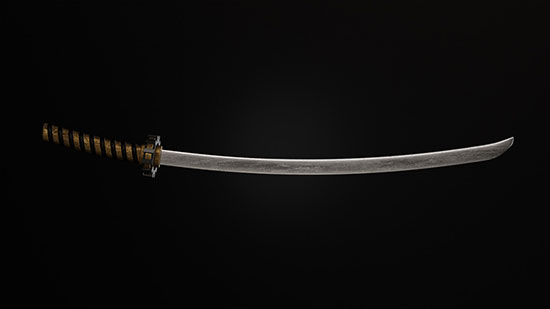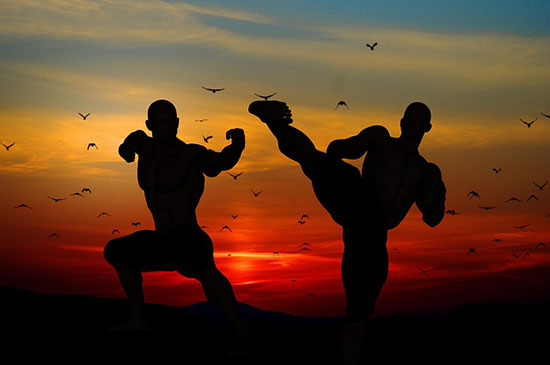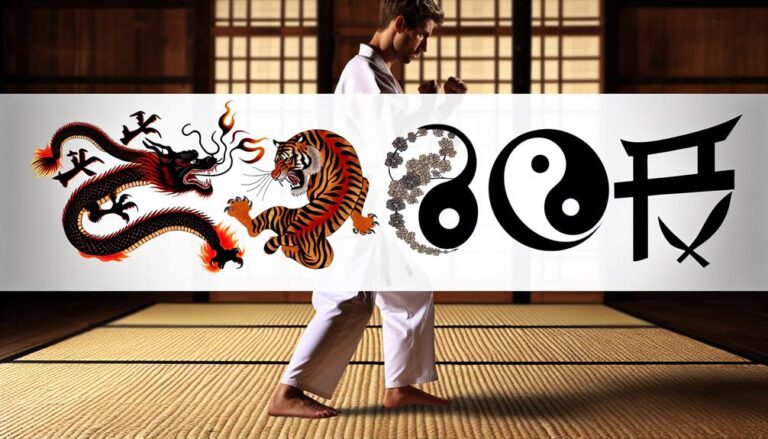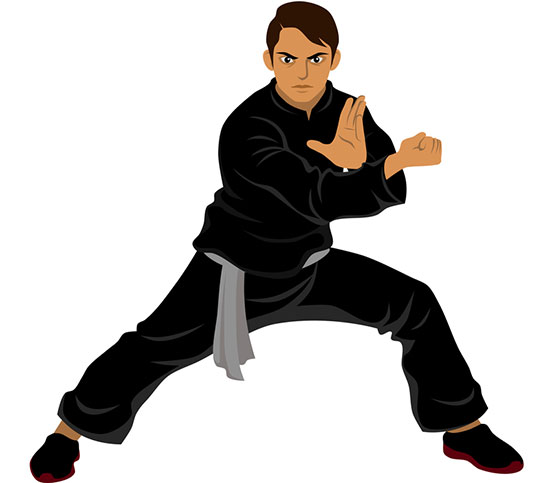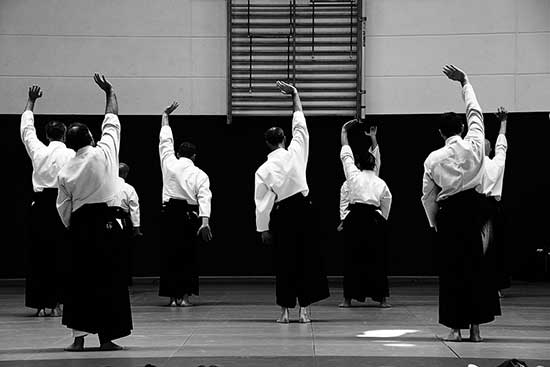Jeet Kune Do, which translates to “Way of the Intercepting Fist,” was developed by the legendary martial artist Bruce Lee. It is a philosophy and martial art that means simplicity, directness, and adaptability.
Jeet Kune Do focuses on using the most efficient techniques from various martial arts styles, discarding unnecessary movements and forms. It encourages practitioners to be fluid and adaptable in their approach, constantly evolving and adapting to different situations.
MMA, on the other hand, is a full-contact combat sport that allows the use of both striking and grappling techniques. It combines various martial arts styles such as boxing, Muay Thai, Brazilian Jiu-Jitsu, wrestling, and judo.
MMA fighters compete in a controlled environment, following specific rules and regulations. The goal of MMA is to find the most effective techniques from different martial arts styles and combine them into a cohesive fighting style.
Understanding the differences between Jeet Kune Do and MMA is crucial for individuals who are interested in practicing martial arts.
While both martial arts share some similarities, such as their focus on practicality and effectiveness, they also have distinct philosophies, training methods, and fighting styles.
Contents
Origins and History of Jeet Kune Do and MMA
Jeet Kune Do was developed by Bruce Lee in the 1960s as a response to the limitations he saw in traditional martial arts. Lee believed that traditional martial arts were too rigid and focused on specific techniques and forms, which he felt limited their effectiveness in real-life combat situations. He sought to create a martial art that was practical, adaptable, and efficient.
Bruce Lee’s influence on Jeet Kune Do cannot be overstated. His philosophy and teachings revolutionized the martial arts world, inspiring countless practitioners to think outside the box and explore new possibilities.
Lee’s emphasis on being like water, flowing and adapting to any situation, became a cornerstone of Jeet Kune Do. His teachings continue to influence martial artists to this day.
MMA, on the other hand, has a more recent history. It emerged in the 1990s as a way to determine the most effective martial art in a real-life combat situation.
The early days of MMA were characterized by no-holds-barred fights, where practitioners of different martial arts styles would compete against each other with minimal rules and regulations. Over time, MMA evolved into a regulated sport with specific rules and weight classes.
The evolution of MMA can be attributed to the influence of various martial arts styles. Fighters from different backgrounds began to cross-train in multiple disciplines, incorporating techniques from boxing, Muay Thai, Brazilian Jiu-Jitsu, wrestling, and other martial arts.
This cross-training led to the development of a more well-rounded and effective fighting style, which eventually became known as MMA.
Philosophy and Principles of Jeet Kune Do and MMA
Jeet Kune Do is guided by a philosophy of simplicity, directness, and adaptability. It emphasizes the use of the most efficient techniques from various martial arts styles, discarding unnecessary movements and forms.
Jeet Kune Do practitioners are encouraged to be like water, flowing and adapting to any situation. The philosophy of Jeet Kune Do extends beyond the physical aspects of martial arts and encompasses a way of life, promoting personal growth and self-expression.
MMA, on the other hand, is guided by a philosophy of practicality and effectiveness. The goal of MMA is to find the most effective techniques from different martial arts styles and combine them into a cohesive fighting style.
MMA fighters are trained to be well-rounded and versatile, capable of both striking and grappling. The philosophy of MMA is rooted in competition, with fighters constantly seeking to improve their skills and test themselves against opponents.
While Jeet Kune Do and MMA share a focus on practicality and effectiveness, their philosophies and principles differ in their approach.
Jeet Kune Do focuses on simplicity and adaptability, while MMA focuses on combining different martial arts styles to create a well-rounded fighting style. Understanding these differences is important for individuals who are considering practicing either martial arts.
Techniques and Training Methods in Jeet Kune Do and MMA
Jeet Kune Do utilizes a range of techniques from various martial arts styles, with an emphasis on intercepting and trapping techniques. Intercepting techniques involve intercepting an opponent’s attack before it reaches its target while trapping techniques involve controlling an opponent’s limbs to neutralize their attacks.
Jeet Kune Do also incorporates striking techniques from boxing and kicking techniques from various martial arts styles.
MMA incorporates a wide range of techniques from different martial arts styles, including striking, grappling, and submissions. Striking techniques from boxing, Muay Thai, and kickboxing are combined with grappling techniques from Brazilian Jiu-Jitsu, wrestling, and judo.
MMA fighters are trained in both striking and grappling, allowing them to effectively engage in all ranges of combat.
The training methods in Jeet Kune Do and MMA also differ. Jeet Kune Do training focuses on developing attributes such as speed, power, timing, and sensitivity. It includes drills that simulate real-life combat situations, allowing practitioners to develop their reflexes and adaptability.
Sparring is an integral part of Jeet Kune Do training, as it allows practitioners to test their skills against resisting opponents.
MMA training, on the other hand, involves a combination of striking and grappling training. Fighters train in various martial arts styles to develop their striking and grappling skills.
They also engage in sparring sessions to practice their techniques and develop their timing and reflexes. MMA training often involves a high level of physical conditioning, as fighters need to be in peak physical condition to compete at a high level.
Rules and Regulations in Jeet Kune Do and MMA
One of the key differences between Jeet Kune Do and MMA is the rules and regulations that govern each martial art. Jeet Kune Do does not have a set of standardized rules, as it is more of a philosophy and approach to martial arts.
Practitioners are encouraged to adapt their techniques and strategies to the situation at hand, without being constrained by specific rules.
MMA, on the other hand, has a set of rules and regulations that govern the sport. These rules vary depending on the organization and jurisdiction but generally include restrictions on techniques such as eye gouging, strikes to the groin, and strikes to the back of the head.
MMA fights are typically conducted in a controlled environment, with referees ensuring the safety of the fighters.
The rules and regulations in MMA have a significant impact on training and competition. Fighters must train within the confines of these rules, focusing on techniques that are allowed in the sport.
This can influence the strategies and techniques that fighters employ in their training and fights. Understanding the rules and regulations of MMA is crucial for individuals who are interested in competing in the sport.
Differences in Fighting Styles and Strategies in Jeet Kune Do and MMA
Jeet Kune Do is known for its fluidity and unpredictability. Practitioners are encouraged to be like water, flowing and adapting to any situation.
Jeet Kune Do fighters are known for their quick footwork, rapid strikes, and ability to seamlessly transition between different ranges of combat.
The fighting style of Jeet Kune Do is characterized by its efficiency and directness, with practitioners seeking to end fights as quickly and decisively as possible.
MMA, on the other hand, is known for its combination of different martial arts styles. Fighters are trained in both striking and grappling, allowing them to effectively engage in all ranges of combat.
MMA fighters often employ a strategic approach, using their knowledge of different martial arts styles to exploit their opponent’s weaknesses.
The fighting style of MMA is characterized by its versatility and adaptability, with fighters constantly adjusting their strategies based on their opponents’ strengths and weaknesses.
Understanding the differences in fighting styles and strategies is important for individuals who are considering practicing either Jeet Kune Do or MMA.
Jeet Kune Do emphasizes fluidity and unpredictability, while MMA focuses on combining different martial arts styles to create a well-rounded fighting style.
Pros and Cons of Practicing Jeet Kune Do and MMA
Both Jeet Kune Do and MMA have their own set of benefits and drawbacks. Practicing Jeet Kune Do can help individuals develop attributes such as speed, power, timing, and adaptability.
It encourages practitioners to think outside the box and be creative in their approach to martial arts. Jeet Kune Do also promotes personal growth and self-expression, allowing individuals to develop their own unique fighting style.
MMA, on the other hand, offers a well-rounded and practical approach to martial arts. It allows individuals to develop both striking and grappling skills, making them versatile fighters. MMA training can also provide individuals with a high level of physical conditioning, as fighters need to be in peak physical condition to compete at a high level.
Additionally, MMA offers the opportunity for individuals to compete in a regulated and controlled environment.
However, there are also drawbacks to consider. Jeet Kune Do does not have a set of standardized techniques or training methods, which can make it difficult for individuals to find a qualified instructor or training program.
MMA, on the other hand, can be physically demanding and potentially dangerous. The risk of injury is higher in MMA due to the full-contact nature of the sport.
Ultimately, the decision to practice Jeet Kune Do or MMA depends on individual preferences and goals. Some individuals may prefer the philosophy and adaptability of Jeet Kune Do, while others may be drawn to the practicality and versatility of MMA.
It is important to consider personal goals, physical abilities, and available resources when choosing a martial art.
Conclusion: Which Martial Art is Right for You?
Choosing the right martial art is a personal decision that depends on individual goals and preferences. Both Jeet Kune Do and MMA offer unique benefits and drawbacks, making it important to carefully consider these factors before making a decision.
Individuals who are interested in a philosophy-based approach to martial arts may find Jeet Kune Do appealing. Jeet Kune Do emphasizes simplicity, adaptability, and personal growth. It encourages practitioners to think outside the box and develop their own unique fighting style.
On the other hand, individuals who are interested in a well-rounded and practical approach to martial arts may find MMA more suitable. MMA offers the opportunity to develop both striking and grappling skills, making individuals versatile fighters. It also provides the opportunity for individuals to compete in a regulated and controlled environment.
Ultimately, the decision between Jeet Kune Do and MMA should be based on individual goals, physical abilities, and available resources. It is important to find a martial art that aligns with personal preferences and allows for personal growth and development. Whether it is Jeet Kune Do or MMA, practicing martial arts can be a rewarding and fulfilling journey.

